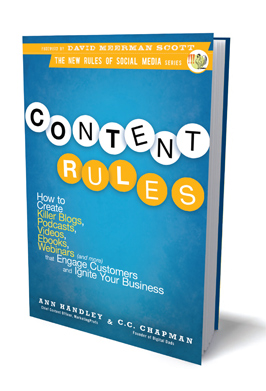One of the realities of social media is that people talk back. They tell you if they like what you are doing. But they are equally quick to tell you what they don’t like about what you are doing.
This can be a painful thing. Anyone who has ever performed in public – and that includes all of us who lay out our ideas on blogs and social media sites – knows the sinking feeling of starting to read a comment when someone says your performance sucked or your ideas were just plain wrong.
For many of us, our first instinct is to run from that type of commentary. We rationalize that paying attention to critics will cause us to have second thoughts, to be timid, or to pull back from taking risks in the future.
Don’t be that person. Don’t shy away from reading and taking criticism to heart.
Listening to and embracing criticism is one of the secrets of the true high performer.
This week, I saw that graphically illustrated when C.C. Chapman came to Canada to talk about Content Rules, the book he co-authored with Ann Handley, at Third Tuesdays in Montreal, Toronto, Calgary, and Vancouver.
I had seen C.C. present at conferences over the past couple years. He’s one of the best. And he met my expectations right from the beginning of this week.
C.C. started strong with a great presentation in Montreal. He hit all the right notes and the audience loved him. In fact, his presentation and the question-and-answer session stretched over 90 minutes before it could be brought to an end.
The next night in Toronto his performance was again strong. But there was some chatter in the back of the room as some people’s attention drifted. I wondered what was going on, why the presentation wasn’t gripping this group the way it had the previous night.
We use Meetup.com to host the Third Tuesday event sites. Meetup has built-in questionnaires to ask users to rate and comment on the speaker’s performance. Overwhelmingly, the comments about C.C.’s Toronto presentation were positive. But there were some criticisms. Some people were looking for more structure in cc presentation. A few event said they hadn’t found the content they expected from C.C.
The next night we were on to Calgary. As he started his presentation, I saw that C.C. had made some changes to it. He added an introduction that provided a quick overview of the content of the book and identified some particular points that he would highlight. In effect, he provided a structure and roadmap to his presentation. It appeared to me that C.C. had read the comments and used them to refine his delivery.
Thanks to the Meetup software, we received a fresh batch of comments after the Calgary event. Again, almost all were positive. A few made suggestions about how C.C. could improve his presentation.
On the final night in Vancouver, C.C. further tightened up his presentation, focusing on a few ideas that had made the most impact on the previous nights. He had again addressed all of the critical comments that had been left on Meetup or in tweets.
I had watched this unfold during the week. But I hadn’t said anything because I thought C.C. was in full flight and he didn’t need any additional kibitzing from me. However, in the taxi after the final event was over, I asked C.C. if he was reading the comments about his presentations as we went along. For sure, he responded.
Over four days and four presentations, one of the best presenters around listened to the criticisms and embraced them. By doing this, he turned an already great presentation into a presentation that received one of the highest ratings achieved in five years of Third Tuesdays.
That’s how C.C. has become a great presenter. Never get mad. Never run away from criticism. Grab it. Use it. That’s how it’s done. That’s something we should all do. In our presentations. In what we write. In our jobs. All the time.







